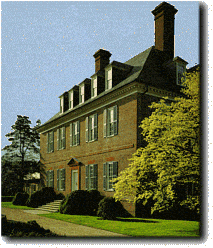

United States History 17A
Tobacco Culture
Adapted from U.B. Phillips, American
Negro Slavery, (1918)
Unlike corn, for example, the seeds
of
which
could be dropped by hand in the field and the mature plants harvested
in
three months time, tobacco seeds were too expensive to risk planting in
this way and too small for this kind of planting to be effective.
(Tobacco
seeds are about the size of finely ground pepper. About ten thousand of
them will fit into a teaspoon).
Tobacco seeds had to be sown in late
winter
or early spring in a special bed of deep forest mold covered with wood
ashes and then tended until they were about the length of and adult's
index
finger. The young plants then were uprooted carefully from their beds
and
planted in the fields, each on its own hill about three or four feet
apart.
This was usually done during or just after an April, May or June rain.
An experienced field hand could transplant them at the rate of several
thousand in a single day. This task had to completed before the ground
became dry enough to endanger the young seedlings' lives.
After the transplanting, the fields
were
plowed
and hoed continuously to prevent the growth of weeds. After a rain, the
plants that had died were replaced. When the first flower bud appeared,
the plant was topped so that only a few choice leaves were left growing
on the stalk. As the plant grew, any suckers growing at the base of the
stalk had to be pulled off. And the underside of every leaf had to be
examined
on a regular schedule for horn-worms. Horn-worm infestations could come
at any time, but they usually came in two gluts -- one when the plants
were half grown, the other when they were nearly ready for harvest. If
not discovered immediately , a whole field could be infected in only a
few days.
When the leaves of the crop began to
turn yellow,
the stalks were cut off close to the ground, and, after they had
wilted,
were carried to a well-ventilated tobacco barn and hung upside down for
curing. Each stalk hung at the proper distance from its neighbor,
attached
to wooden lath strips laid perpendicular on the roof joists. The crop
stayed
in this barn for several months, with the windows open in dry weather
and
closed in wet. When the weather was moist enough to make the leaves
pliable,
some slaves lowered the stalks to the floor, where the rest of the
group,
working in threes, stripped the leaves off the stalks. One took off the
rejected leaves, or culls, another stripped the best, or bright leaves,
and another the leaves with dull color. Each then bound his takings
into
"hands" of about a quarter of a pound each and sorted them into piles.
Next came the packing or prizing
stage,
during
which a barefoot man inside a large barrel, or hogshead, laid the
sorted
bundles of leaves in rows, tramping them down gently. Then a second
hogshead,
without a bottom, was set on top of the first and filled in the same
way,
and, then, perhaps even a third would be filled in a similar manner.
Finally,
the whole stack was put under blocks and levers and the contents of all
three hogsheads compressed into the one at the bottom. A top was then
nailed
in place, and the hogshead rolled down to a nearby river where a
waiting
ship took it to market, probably in England. Often a crop was not cured
enough for prizing until the next crop had been planted. Hence the need
to have enough resources to survive this long growing process until the
tobacco crop could be sold.
Answer the following questions
16. What three things did one need to grow tobacco
successfully
in the Chesapeake?
17. How long could it take before a profit might
be
realized
from planting tobacco?
18. Why couldn't tobacco seeds be sown directly
in
the fields?
19. How many tobacco seeds will fit into a
teaspoon?
20. How many tobacco plants could be transplanted
in
a single
day by an experienced hand?
21. Why were tobacco plants topped?
22. What could infect a whole field within a few
days?
23. Where and for how long did the curing process
take place?
24. What were the best and worst leaves called?
25. What was a hogshead? What was prizing?
How
was
the cured tobacco sent to market?
26. Often a tobacco crop was not cured for
prizing
until
___ ?
After you have finished the first assignment page,
you may
want to rent the movie, Shakespeare in Love. See if you
can
identify the glaring historical error concerning the reference
to
tobacco plantations in Virginia?

 Return
to Study Guide #1
Return
to Study Guide #1
 Revised January 24,
2008
Revised January 24,
2008
by Tom Gallup, e-mail address: [email protected]
West Valley College
http://www.westvalley.edu/wvc/ss/gallup/gallup.html



![]() Revised January 24,
2008
Revised January 24,
2008